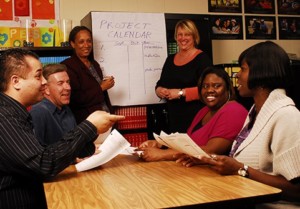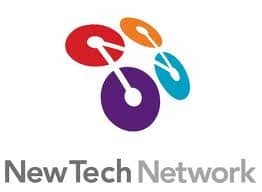From Designing Project-Based Learning to Designing Professional Development
Key Points
-
Coaching PBL is collaborative work.
-
It’s a process of asking how we might meet these challenges and then working together collaboratively to push it forward.

By: Matthew Leader
One of the things I most appreciate about working at High Tech High (HTH) is that, in addition to teaching middle and high school students throughout my tenure, I’ve been able to help other teachers incorporate project-based learning (PBL) into their own practice. PBL is an integral part of our approach to teaching and learning and, over the years, our organization has grown from a single high school to 16 elementary, middle, and high schools, as well as a graduate school of education (where I earned my own master’s degree).
Since 2019, I’ve had the opportunity to work with educators from the Ulster Board of Cooperative Educational Services (BOCES) as part of a partnership that has connected teachers and students from San Diego, CA, to New Paltz, NY. Here’s how it works.
From Teacher to Trainer
High Tech High is a publicly funded charter school organization centered on PBL and guided by four design principles of equity, personalization, authentic work, and collaborative design. As our organization has expanded to add more schools, I’ve worked at several of our campuses, at both the high school and middle school level, over the years.
Though our funding comes from a statewide benefit for charter schools, we are embedded in the San Diego Unified School District. Students apply to attend and are selected through a lottery. A certain percentage of students from each zip code from across San Diego County is accepted to ensure a student body with diverse demographic and socioeconomic backgrounds.
As more educators outside our school became interested in project-based learning, we began offering PBL 101 professional learning opportunities to other schools. In the beginning, these usually consisted of teachers visiting our campus and seeing how we worked with students. Over time, some of us teachers had the opportunity to visit other schools to share an overview, and later, we began offering professional development facilitation through our graduate school and coaching as a follow-up. Today, our graduate school offers a range of other in-person and online events to further project-based learning through collaboration with other educators and schools around the world.
It’s work that comes on top of my teaching time, but I love it. We have many unique opportunities at HTH, and being able to work with other schools is one of the many things that I enjoy.
Partnering with Ulster BOCES
We began working with Ulster BOCES in 2019. Having an ongoing relationship with teachers over the years, and seeing new teachers come in as ideas have been disseminated through their district, has been amazing.
The first time that we went to Ulster, we worked with a single-component district. It was productive because they had visited HTH, were familiar with how we did things and knew exactly what they wanted from us. It was a really good fit in terms of us sharing what we do and then receiving feedback. I’ve been brought out to coach there six or seven times now, and it’s definitely a two-way relationship in that I always come back with new ideas for my own practice. After seeing teachers from Ulster’s Hudson Valley Pathway Academy (P-TECH) facilitate an exhibition of student work in front of their community project partners at Viking Packaging, for example, I started implementing their format for panel discussions of student products. Their system for feedback specific to product improvement was great, with benefits to both students and community partners and I have used it ever since.
About 50-60 educators attend the professional development workshops we’ve offered at Ulster this year, which were held in October and January, with one more to go in May. In the professional development sessions, we have everyone from administrators to first-year teachers. It’s difficult to get into solving specific problems in that context, but it provides a good look at the big picture. If a school is really going to dig into PBL, getting everyone together to see how it works from a range of perspectives is useful to everyone involved, even if they’re each only going to use the information in specific ways.
Coaching sessions are attended more on a drop-in basis by teachers who feel a need for some additional support. These are held monthly and attended by different people each time. There are usually about 15 educators in each session.
One of the highlights of working with Ulster has been the freedom they give us to share what we think will be best for their teachers. Having the autonomy as a designer of professional development to be able to ask what is going to work for each specific group allows us to have workshops that are as effective as possible. We have a lot of meetings before the early sessions, especially to talk about what is happening at each new school coming in.
Hudson Valley P-TECH has been a big collaborator from 2019 to today. We’ve collaborated on projects that allowed our students to meet their students, which has been really meaningful. A great example of project collaboration came during the pandemic, when another HTH teacher, Matt Haupert, collaborated with Steve Mason, a P-TECH teacher, to start a virtual project-based summer school course in which students from classes in the Hudson Valley and San Diego worked together to create their own online media publication called Teen Voices. Students worked with a variety of professional journalists and developed everything for the site, including written content, graphic design, and website layout.
A True Collaboration
We spend a lot of time planning the professional development sessions, with the first and third taking place in New York, and the second here in California. The coaching takes place monthly, which provides a great opportunity for us to receive feedback to refine further workshops. Teachers drop into those coaching sessions to get help on whatever they’re working on, so we can plan activities that are more likely to help them further their practice in the next session or the next workshop. During these coaching sessions, we have worked on elements of PBL such as scaffolding critique and revision lessons, ideating for launch ideas and setting up plans for school exhibitions. Most recently we discussed collaboration between teachers and hospital staff at Health Alliance as part of an upcoming health project.
Coaching is collaborative work. The teachers who show up have questions about how they are implementing PBL ideas, but once the questions are out there, we shift and begin working together. It’s a process of asking how we might meet these challenges and then working together collaboratively to push it forward. It’s not me saying, “This is what I do, so you should do this.” It’s me saying, “This is what worked for me as a teacher,” and then the other educators in the room sharing ideas that might also work. We’re all teachers, all dealing with the same things, so how do we make it work? As a teacher who’s been on the other end of coaching myself, I appreciate having an outside voice that isn’t embedded in my classroom to act as a sounding board and source of feedback.
I love working at High Tech High because I get to design with and for my students, and that means we’re always doing something innovative and new. I love coaching opportunities like the one I’ve enjoyed with Ulster for the same reasons. I get to work with teachers who are trying to solve a range of challenges and it’s always exciting to see how we’ll work together to find solutions.
Matthew Leader is a biology teacher at High Tech High. A native of San Diego, he received a Bachelor of Science degree from the University of California at San Diego in General Biology and Teaching Credentials at San Diego State University. Matthew is an Americorps alumni, Socrates fellow alumni and he completed a Masters in Education in Teacher Leadership at the HTH Graduate School of Education. He can be reached at [email protected]







0 Comments
Leave a Comment
Your email address will not be published. All fields are required.